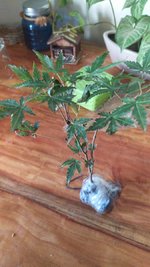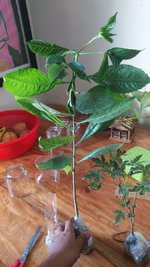@Maheshbiyer, do you know the species name of your baobab? Where did you get it from?
One of the first things baobabs invest in is a storage root. It's critical for them be able to store enough water to survive their first drought. Mine have all been grown from seed. By the time the cotyledons have opened, the tap root is already quite long. Here is a picture of one of mine after ~3 months growth:
View attachment 335638
You can see that already the tap root is quite bulbous.
Do you happen to take a picture of the roots? There should be an existing tap root or evidence that one has been cut. It's quite possible the one on yours has been cut or has been constrained to a small container. Either way, it should be obvious. There should either be a wound where the root was cut or the root will be twisted and bulbous because it was constrained and had nowhere to go.
If there isn't some evidence of a storage root, I'd question whether it is a true adansonia.
As far as what to do with it...that partly depends on if it is a true adansonia or not. If it's not a true adansonia, my experience with them is not likely to help you!
Assuming it IS an adansonia, I don't like to tell people what to do. It's your tree...not mine

What I can do is tell you what I have done with mine, explain why, and show the results...which is what my previous post was attempting to do.
At the risk of repeating:
My adansonia digitata (what yours is most likely to be if it is an adansonia) is currently growing in a 3 gallon grow bag. I use these
I can usually get them for under $3 per bag and they last me 5 years or more. Many people on this site will use plastic colanders. I prefer the bags myself, but the principal is the same: when the roots hit the air boundary, they don't turn and continue to grow like they would in a traditional pot. Instead, the tips naturally dry up and die. The root then branches further back. Over time this leads to lots of fine "feeder" roots that help the tree absorb water and nutrients. The bags aren't as effective as colanders. I do get some fine roots that do weave into the bag itself if I keep the soil too wet. But it's plenty effective for my use and they last me longer.
I have my doubts that that is necessary with adansonia and the way they grow roots, but it doesn't hurt. At the very least, I can water them constantly and the porous bag allows the soil to drain immediately. The bags dry out enough during the day to keep root rot from being an issue. I water my babs every day...sometimes twice a day...during their growing season without worry about rot issues. Part of that is that the bags dry out quicker than posts. Part of that is the soil I use doesn't get muddy.
The "soil" I have mine in I buy at a local auto parts store. It's known in the US as NAPA 8822. It's used to soak up oil spills of all things

What it really is is diatomaceous earth:

en.wikipedia.org
There are many uses for DE. Finely powedered DE is sometimes used as a food additive. Do not use the food grade stuff! It's too fine. Powedered DE is also used as an insect/slug barrier. Sometimes even as an insecticide. The fine powder is very sharp and hard. It can get between the segments of insects and cause wounds that will dry the insect out and kill it. Ants won't cross it. Slugs won't either. The power is also used as a soil additive in the garden for various reasons beyond insect prevention. Again, do not use the powered stuff!
What I use comes in 1-2mm pebbles. I believe DE is sold in some European countries as kitty litter. I use it because it is cheap and easy to source here. It lasts many years...I often wash and reuse it after a repot. It's not organic so I don't tend to get fungus gnat infestations when I move things inside for the winter. The downside is there are no usable nutrients...I do need to fertilize regularly.
I started most of my adansonia seedlings in coconut coif. They actually grew in coconut coif for most of their first year. They did seem to grow much faster in the coif but the coif was much harder to control the moisture of. It breaks down pretty fast and sometimes felt muddy and took longer than I would like to dry out. I started to worry about root rot issues after just 6 months in coif so I moved them to DE instead. I wasn't terribly happy with the rate of growth this season in the DE compared to last where most of the growth was in the early part of the season when they were in coconut coif. I may make some adjustments next season towards something a little more moisture retaining.
The results are as pictured:
View attachment 335651View attachment 335650View attachment 335649
All 3 are adansonia digitata. All 3 trees are 2 years from seed. They are just over 1m tall. Trunks at the base are just shy of 3cm. The 2 on the right were topped at the end of last season to try and force some back budding...which they did do.
So again, that's what I have done. You are in a much different climate than mine. My adansonia cannot survive outside year round here. We'll be dropping below 0C at night any day now. Temps as low as -20C are not out of the question here. Even in the summer, when our temps can get to above 35C, our humidity is often 80%. All I can do is try things and see what works for me.
Lots of words...sorry! But hopefully I've explained the reasoning behind my decisions enough that you can adjust what I've done to your climate.



















